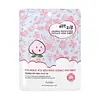What's inside
What's inside
 Key Ingredients
Key Ingredients

 Benefits
Benefits

 Concerns
Concerns

No concerns
 Ingredients Side-by-side
Ingredients Side-by-side

Water
Skin ConditioningGlycerin
HumectantAlcohol
AntimicrobialPEG/PPG-17/6 Copolymer
SolventButylene Glycol
HumectantSolanum Lycopersicum Fruit Extract
AntioxidantPunica Granatum Fruit Extract
AntioxidantHippophae Rhamnoides Extract
MaskingSodium Hyaluronate
HumectantBeta Vulgaris Root Extract
Skin ConditioningPrunus Persica Fruit Extract
AbrasiveCarbomer
Emulsion StabilisingTriethanolamine
BufferingXanthan Gum
EmulsifyingPEG-60 Hydrogenated Castor Oil
EmulsifyingPropylene Glycol
HumectantBetaine
HumectantDisodium EDTA
Methylparaben
PreservativePhenoxyethanol
Preservative1,2-Hexanediol
Skin ConditioningEthylhexylglycerin
Skin ConditioningCaprylyl Glycol
EmollientParfum
MaskingHexyl Cinnamal
PerfumingLinalool
PerfumingCitronellol
PerfumingWater, Glycerin, Alcohol, PEG/PPG-17/6 Copolymer, Butylene Glycol, Solanum Lycopersicum Fruit Extract, Punica Granatum Fruit Extract, Hippophae Rhamnoides Extract, Sodium Hyaluronate, Beta Vulgaris Root Extract, Prunus Persica Fruit Extract, Carbomer, Triethanolamine, Xanthan Gum, PEG-60 Hydrogenated Castor Oil, Propylene Glycol, Betaine, Disodium EDTA, Methylparaben, Phenoxyethanol, 1,2-Hexanediol, Ethylhexylglycerin, Caprylyl Glycol, Parfum, Hexyl Cinnamal, Linalool, Citronellol
Water
Skin ConditioningGlycerin
HumectantMethylpropanediol
SolventAgave Americana Stem Extract
Skin Conditioning1,2-Hexanediol
Skin ConditioningAllantoin
Skin ConditioningAlthaea Rosea Flower Extract
Skin ConditioningButylene Glycol
HumectantCaffeine
Skin ConditioningCaprylyl Glycol
EmollientCarbomer
Emulsion StabilisingCassia Angustifolia Seed Polysaccharide
Skin ConditioningCellulose Gum
Emulsion StabilisingDisodium EDTA
Ethylhexylglycerin
Skin ConditioningHydroxyacetophenone
AntioxidantHydroxyethyl Urea
HumectantLaminaria Digitata Extract
Skin ProtectingPEG-40 Hydrogenated Castor Oil
EmulsifyingPhenoxyethanol
PreservativeSodium Hyaluronate
HumectantTromethamine
BufferingWater, Glycerin, Methylpropanediol, Agave Americana Stem Extract, 1,2-Hexanediol, Allantoin, Althaea Rosea Flower Extract, Butylene Glycol, Caffeine, Caprylyl Glycol, Carbomer, Cassia Angustifolia Seed Polysaccharide, Cellulose Gum, Disodium EDTA, Ethylhexylglycerin, Hydroxyacetophenone, Hydroxyethyl Urea, Laminaria Digitata Extract, PEG-40 Hydrogenated Castor Oil, Phenoxyethanol, Sodium Hyaluronate, Tromethamine
 Reviews
Reviews

Ingredients Explained
These ingredients are found in both products.
Ingredients higher up in an ingredient list are typically present in a larger amount.
1,2-Hexanediol is a synthetic liquid and another multi-functional powerhouse.
It is a:
- Humectant, drawing moisture into the skin
- Emollient, helping to soften skin
- Solvent, dispersing and stabilizing formulas
- Preservative booster, enhancing the antimicrobial activity of other preservatives
Butylene Glycol (or BG) is used within cosmetic products for a few different reasons:
Overall, Butylene Glycol is a safe and well-rounded ingredient that works well with other ingredients.
Though this ingredient works well with most skin types, some people with sensitive skin may experience a reaction such as allergic rashes, closed comedones, or itchiness.
Learn more about Butylene GlycolCaprylyl Glycol is a humectant and emollient, meaning it attracts and preserves moisture.
It is a common ingredient in many products, especially those designed to hydrate skin. The primary benefits are retaining moisture, skin softening, and promoting a healthy skin barrier.
Though Caprylyl Glycol is an alcohol derived from fatty acids, it is not the kind that can dry out skin.
This ingredient is also used as a preservative to extend the life of products. It has slight antimicrobial properties.
Learn more about Caprylyl GlycolCarbomer is a polymer of acrylic acid. Its main role is to create a gel consistency.
A high amount of carbomer can cause pilling or balling up of products. Don't worry, most products contain 1% or less of carbomer.
Disodium EDTA plays a role in making products more stable by aiding other preservatives.
It is a chelating agent, meaning it neutralizes metal ions that may be found in a product.
Disodium EDTA is a salt of edetic acid and is found to be safe in cosmetic ingredients.
Learn more about Disodium EDTAEthylhexylglycerin (we can't pronounce this either) is commonly used as a preservative and skin softener. It is derived from glyceryl.
You might see Ethylhexylglycerin often paired with other preservatives such as phenoxyethanol. Ethylhexylglycerin has been found to increase the effectiveness of these other preservatives.
Glycerin is already naturally found in your skin. It helps moisturize and protect your skin.
A study from 2016 found glycerin to be more effective as a humectant than AHAs and hyaluronic acid.
As a humectant, it helps the skin stay hydrated by pulling moisture to your skin. The low molecular weight of glycerin allows it to pull moisture into the deeper layers of your skin.
Hydrated skin improves your skin barrier; Your skin barrier helps protect against irritants and bacteria.
Glycerin has also been found to have antimicrobial and antiviral properties. Due to these properties, glycerin is often used in wound and burn treatments.
In cosmetics, glycerin is usually derived from plants such as soybean or palm. However, it can also be sourced from animals, such as tallow or animal fat.
This ingredient is organic, colorless, odorless, and non-toxic.
Glycerin is the name for this ingredient in American English. British English uses Glycerol/Glycerine.
Learn more about GlycerinPhenoxyethanol is a preservative that has germicide, antimicrobial, and aromatic properties. Studies show that phenoxyethanol can prevent microbial growth. By itself, it has a scent that is similar to that of a rose.
It's often used in formulations along with Caprylyl Glycol to preserve the shelf life of products.
Sodium Hyaluronate is hyaluronic acid's salt form. It is commonly derived from the sodium salt of hyaluronic acid.
Like hyaluronic acid, it is great at holding water and acts as a humectant. This makes it a great skin hydrating ingredient.
Sodium Hyaluronate is naturally occurring in our bodies and is mostly found in eye fluid and joints.
These are some other common types of Hyaluronic Acid:
Learn more about Sodium HyaluronateWater. It's the most common cosmetic ingredient of all. You'll usually see it at the top of ingredient lists, meaning that it makes up the largest part of the product.
So why is it so popular? Water most often acts as a solvent - this means that it helps dissolve other ingredients into the formulation.
You'll also recognize water as that liquid we all need to stay alive. If you see this, drink a glass of water. Stay hydrated!
Learn more about Water